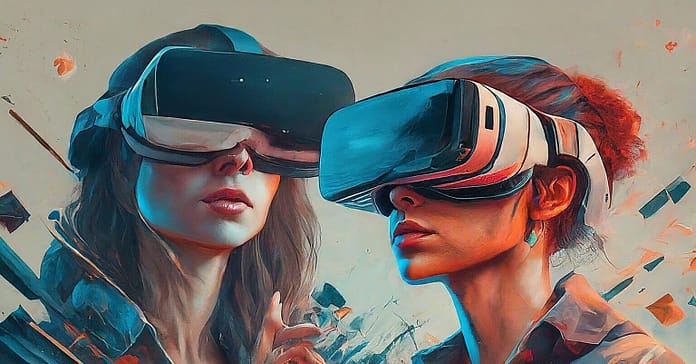The boundaries between the physical and virtual worlds are melting faster than a pixelated ice cream cone on a virtual beach. This convergence isn’t a dystopian plot twist from a sci-fi movie; it’s the exciting rise of immersive AR/VR integration, a technological fusion propelling us towards a future where real and virtual seamlessly blend.
But what exactly does this integration entail? Imagine attending a concert where holographic performers grace a real-world stage, their digital pyrotechnics lighting up the night sky. Picture exploring a museum exhibit where dinosaurs roar to life in augmented reality, their scales shimmering with intricate detail. Envision collaborating with colleagues across the globe in a virtual workspace, avatars replicating their body language and expressions in real-time. These are just glimpses of the immersive experiences AR/VR integration promises.
From Entertainment to Enterprise:
This blurring of lines isn’t solely for entertainment. Businesses are diving headfirst into the enterprise metaverse, utilizing AR/VR integration for:

- Training: Imagine doctors virtually practicing complex surgeries in hyper-realistic environments or pilots honing their skills in simulated cockpits. The possibilities for immersive training are vast, offering unparalleled safety and efficiency.
- Collaboration: Virtual meetings take on a whole new meaning when avatars convene in shared 3D spaces, fostering deeper engagement and understanding between geographically dispersed teams.
- Product Launches: Unveiling a new car through an interactive AR experience where users explore its features virtually, or showcasing a clothing line with AI-powered virtual try-on sessions – these are just a few ways businesses can leverage AR/VR integration to create captivating product launches.
- Events: Virtual conferences and tradeshows become vibrant, interactive experiences, allowing attendees to network, access information, and participate in sessions in a truly immersive way.
Technical Magic Behind the Curtain:
This seamless integration relies on advancements in various technologies:
- High-fidelity rendering: Creating realistic virtual elements that seamlessly blend with the real world requires significant graphics processing power, which is becoming increasingly accessible thanks to evolving hardware and software.
- Real-time tracking and mapping: Precise tracking of users’ movements and their environment is crucial for AR overlays to align perfectly with reality. Advancements in LiDAR, spatial mapping, and computer vision are making this possible.
- Haptic feedback and sensory immersion: Touching a virtual object shouldn’t feel like petting a flat screen. Advanced haptic technology helps bridge the sensory gap, enhancing the feeling of presence and realism.

Beyond the Hype: Challenges and Considerations:
While the possibilities are exciting, challenges remain:
- Accessibility: High-end AR/VR headsets can be expensive, potentially creating a digital divide. Affordable and user-friendly alternatives are crucial for widespread adoption.
- Privacy and security: As real and virtual worlds intertwine, data privacy and security concerns become paramount. Robust regulations and ethical considerations are essential.
- Mental health and addiction: The immersive nature of these technologies raises concerns about potential overuse and its impact on mental well-being. Responsible design and usage guidelines are necessary.
The Future Beckons:
Despite these challenges, the potential of immersive AR/VR integration is undeniable. It’s not just about fancy gadgets; it’s about transforming how we learn, work, play, and connect. As technology continues to evolve, the lines between real and virtual will continue to blur, opening doors to a future where imagination becomes reality. Are you ready to step into this new world?

